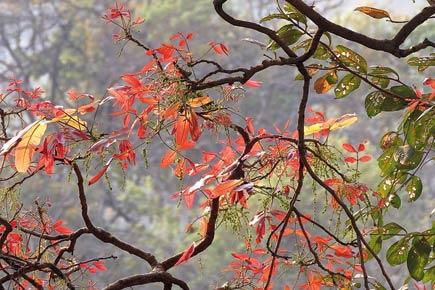While shopping-crazy Mumbaikars were haggling with vendors, gorging on Diwali sweets or going insane explaining the hazards of fire crackers, I was missing my days in Europe and the US

 While shopping-crazy Mumbaikars were haggling with vendors, gorging on Diwali sweets or going insane explaining the hazards of fire crackers, I was missing my days in Europe and the US. Although the crazy Halloween celebrations aren’t my idea of fun, the walks along streets watching orange, yellow, red and brown maple and other tree leaves gently float down, were simply magical. The temperate part of the Northern Hemisphere now gets ready for the freezing white winter and the fall colours are probably a colourful antidote to maintain an overall upbeat mood. Hordes of tourists spend thousands of dollars each year to enjoy these fall colours, visiting, Canada, US, Norway, Switzerland and such hilly regions.
While shopping-crazy Mumbaikars were haggling with vendors, gorging on Diwali sweets or going insane explaining the hazards of fire crackers, I was missing my days in Europe and the US. Although the crazy Halloween celebrations aren’t my idea of fun, the walks along streets watching orange, yellow, red and brown maple and other tree leaves gently float down, were simply magical. The temperate part of the Northern Hemisphere now gets ready for the freezing white winter and the fall colours are probably a colourful antidote to maintain an overall upbeat mood. Hordes of tourists spend thousands of dollars each year to enjoy these fall colours, visiting, Canada, US, Norway, Switzerland and such hilly regions.

ADVERTISEMENT
I, too, have taken the above mentioned excursions but also ventured into the Indian Himalaya right from Kashmir to Arunachal and encountered the same phenomenon occurring in our high-altitude temperate zones. However, there is less glamour and pride for boastful Indians in exploring their own countryside. Parts of West Bengal, Darjeeling, Sikkim, Himachal or even Kashmir are easily accessible by train and flights and a weeklong tour can let you soak in the magical fall colours of our local oaks, elms, birch, maples and horse chestnuts.
Typically then, one would imagine it to be a temperate occurrence and our Western Ghats to be devoid of such fall colours. So, to test my theory that fall colours are visible even in Peninsular India, since the last few years, I have been documenting and observing the changing colours during autumn right here within our Mumbai city.
The most famous urban candidate is obviously the vilayati badam, whose lush green leaves turn to a deep orange-red around mid-November. Not to be outdone, the red silk cotton, Behda and even peepul bear leaves with varying shades of red, orange and yellow, on their way to senescence (old age). Since most of these trees are deciduous, after shedding the colourful leaves they lie brown, leafless and stark. The most striking of these is the ghost tree. During its green-leaved phase the tree has a pinkish bark. But the moment its leaves turn yellow and shed, the bark too flakes and exposes a ghastly white layer. Then this tree growing on rocky slopes stands out even from a distance and is colloquially also called the ‘Naked Maiden’ of the forest.
If you are in the city, the bright, brown fruits of the Copperpod and the red tri-lobed fruits of Jungli Badam trees mark the urban autumn colours. Of course, one can never forget the weak Gulmohar, which sheds millions of tiny yellow leaflets all over the driveway and streets, along with some twigs and pods. In older localities one can spot the yellowing leaves of Ananta, Bhend, Kachnar and Kailashpati or Cannonball trees.
Last week, I explored a few trails in the Sanjay Gandhi National Park and the two star colourful trees in the forest were the young leaves of Mahua and Kusum, with deep red, purple and velvety leaves. Just walk along the Malad Trail or Phansachapani Route and you will be amazed at the diverse shades the forest has to offer in November. The occasional Chironji tree with its deep and prominent mid-rib also shows yellowing of leaves, as do the kakad trees. The Bheeshmasan and Taman or Queen’s flower also shed light red leaves, which eventually turn brown. If the colours of these trees weren’t enough, next time we shall look at all the migratory birds that bring glamour, brightness, chirp and a sort of mellow shine to our mildly cooling city weather. Till then, be sure to photograph and enjoy even the carpets of varying brown leaves on your colony floor. But do ensure that your gardener doesn’t burn them to 50 shades of grey leaf ashes.
Write in to Anand Pendharkar at sproutsonline@gmail.com
 Subscribe today by clicking the link and stay updated with the latest news!" Click here!
Subscribe today by clicking the link and stay updated with the latest news!" Click here!







